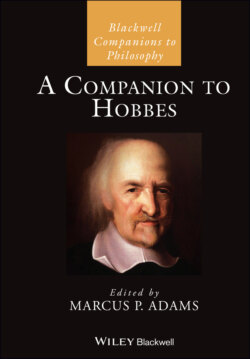Читать книгу A Companion to Hobbes - Группа авторов - Страница 14
2.2 Human Nature and Morality
ОглавлениеR.W. McIntyre’s chapter “‘A Most Useful Economy’: Hobbes on Linguistic Meaning and Understanding” directs attention to the human/non-human animal divide to make sense of the role of names in language. McIntyre argues that for non-human animals, like dogs and cats, names play the role of natural signs of the passions and the will. A dog, for example, will take an instance of the name ‘walk’ as a sign that their owner is about to get the leash and take them outside. However, for humans who are competent at using language names function as symbols that aid in helping bring to mind conceptions that will guide inferences and ultimately human behavior. Beyond aiding in the increase of prudence, this ability to understand words as words that Hobbes posits allows humans to acquire universal knowledge, e.g., of all triangles, while maintaining his commitment to nominalism.
In “Hobbes’s Theory of the Good: Felicity by Anticipatory Pleasure,” Arash Abizadeh shows how Hobbes’s account of felicity was influenced by and modified ideas from Ancient Greek ethics. Abizadeh argues that Hobbes posits an ultimate, overarching good for a human life, which Hobbes conceives not as a final end or state to be realized but as an ongoing process of experiencing greater pleasures relative to pains. Contrasting Hobbes’s understanding of felicity with that of the Epicureans and the Cyrenaics, Abizadeh depicts a Hobbes who holds that felicity consists primarily in the mental pleasures arising from anticipating the satisfaction of one’s desires.
The role fear plays in humans’ escape from their natural state, as well as within the commonwealth after it has been established, has always been a point of focus among interpreters of Hobbes. Gabriella Slomp, in the chapter “In Search of ‘A Constant Civill Amity’: Hobbes on Friendship and Sociability,” compares Hobbes’s views with Aristotle’s and shows how Hobbes’s account differs in terms of the origin, nature, and conditions of “civill amity” within political states. On Slomp’s account, what emerges is a picture of Hobbesian amity that results not from reciprocity of love or care but rather from a shared understanding of the function of the Leviathan and the effort among its citizens to support it.
In the chapter “Hobbes on Power and Gender Relations,” Sandra Leonie Field considers what Hobbes’s philosophy offers to help make sense of gender relations. Field distinguishes between two models of interpersonal power relations: the dominion model and the deference model. The dominion model, which represents power as a vertical relationship of the subjection of one person to another, has been frequently associated with Hobbes by feminist scholars. While this model is reflected in Hobbes’s writings, Field suggests that this model has difficulty making sense of gender relations in a post-coverture world. In its place, Field draws attention to the deference model, which understands the complex and often non-vertical ways in which power can be expressed in gender relations. Not only does this model better aid in understanding contemporary power relations, but Field shows that this model can be found within Hobbes’s thought.
The natural state of humans – the state of nature – is one of the most evocative parts of Hobbes’s philosophy. Against understanding the state of nature as diametrically opposed to the state of civil society, S.A. Lloyd’s chapter “The State of Nature as a Continuum Concept” argues that the state of nature differs from civil society in degrees. In other words, there are states of nature rather than a simple line that is crossed upon the formation of a commonwealth. Lloyd articulates this spectrum as ranging from a condition of mere nature, characterized by a universal right of private judgment, to a perfectly totalitarian state. This approach to Hobbes’s state of nature offers an understanding of humans’ natural state that can make sense of how imperfect political systems are more or less like the mere state of nature. Lloyd argues that the continuum view is more theoretically and empirically plausible than alternative views that claim that Hobbes saw civil society as always at risk of falling back, at any moment, into the mere state of nature.
Michael Green’s chapter “Hobbes’s Minimalist Moral Theory” challenges conceptions of Hobbes’s moral theory that have taken it to follow from broader aspects of Hobbes’s philosophy, such as an aim to harmonize morality with one’s self-interest, as a type of divine-command theory, or following from an account of rationality. In place these accounts, which Green identifies as maximalist theories, Green offers a minimal theory relying upon two theses drawn from Hobbes’s discussions of the Laws of Nature: the value thesis, which holds that the laws are valued because of their role in preserving peace, and the conditional thesis, which holds that what the laws require depends upon what others do. In contrast to more maximal moral theories, Green shows that with only this minimal theory Hobbes can accomplish his goals of arguing for the benefits of the state and constructing an alternative to Aristotle’s theory of justice.
